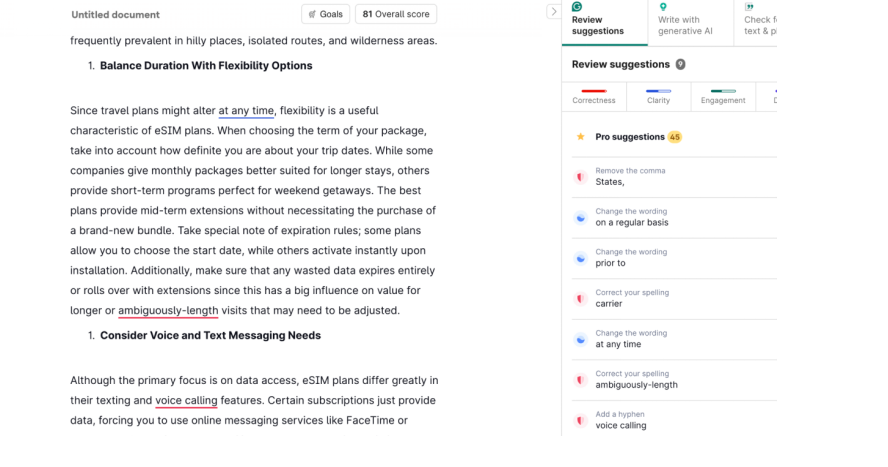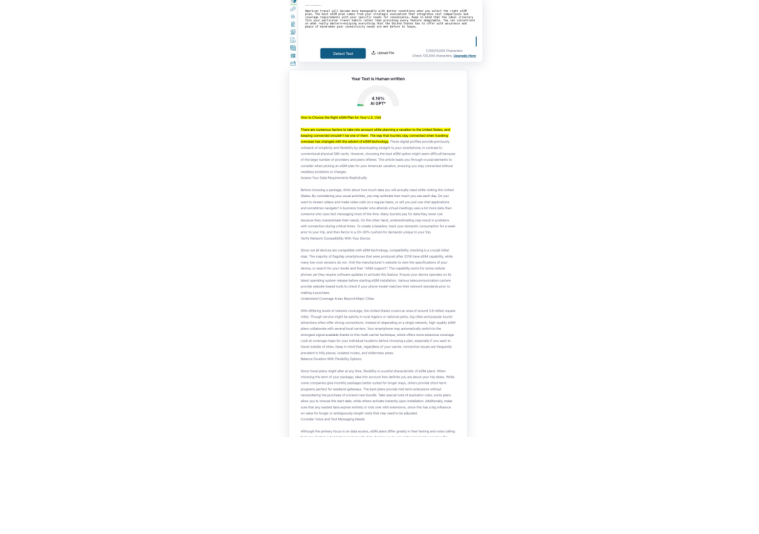There are numerous factors to take into account while planning a vacation to the United States, and keeping connected shouldn’t be one of them. The way that tourists stay connected when traveling overseas has changed with the advent of eSIM technology. These digital profiles provide previously unheard-of simplicity and flexibility by downloading straight to your smartphone, in contrast to conventional physical SIM cards. However, choosing the best eSIM option might seem difficult because of the large number of providers and plans offered. This article leads you through crucial elements to consider when picking a best eSIM in USA plan for your American vacation, ensuring you stay connected without needless problems or charges.
1. Assess Your Data Requirements Realistically
Before choosing a package, think about how much data you will actually need while visiting the United States. By considering your usual activities, you may estimate how much you use each day. Do you want to stream videos and make video calls on a regular basis, or will you just use chat applications and sometimes navigate? A business traveler who attends virtual meetings uses a lot more data than someone who uses text messaging most of the time. Many tourists pay for data they never use because they overestimate their needs. On the other hand, underestimating may result in problems with connection during critical times. To create a baseline, track your domestic consumption for a week prior to your trip, and then factor in a 20–30% cushion for demands unique to your trip.
2. Verify Network Compatibility With Your Device
Since not all devices are compatible with eSIM technology, compatibility checking is a crucial initial step. The majority of flagship smartphones that were produced after 2018 have eSIM capability, while many low-cost versions do not. Visit the manufacturer’s website to view the specifications of your device, or search for your model and then “eSIM support.” The capability exists for some cellular phones yet they require software updates to activate this feature. Ensure your device operates on its latest operating system release before starting eSIM installation. Various telecommunication carriers provide website-based tools to check if your phone model matches their network standards prior to making a purchase.
3. Understand Coverage Areas Beyond Major Cities
With differing levels of network coverage, the United States covers an area of around 3.8 million square miles. Though service might be patchy in rural regions or national parks, big cities and popular tourist attractions often offer strong connections. Instead of depending on a single network, high-quality eSIM plans collaborate with several local carriers. Your smartphone may automatically switch to the strongest signal available thanks to this multi-carrier technique, which offers more extensive coverage. Look at coverage maps for your individual locations before choosing a plan, especially if you want to travel outside of cities. Keep in mind that, regardless of your carrier, connection issues are frequently prevalent in hilly places, isolated routes, and wilderness areas.
4. Balance Duration With Flexibility Options
Since travel plans might alter at any time, flexibility is a useful characteristic of eSIM plans. When choosing the term of your package, take into account how definite you are about your trip dates. While some companies give monthly packages better suited for longer stays, others provide short-term programs perfect for weekend getaways. The best plans provide mid-term extensions without necessitating the purchase of a brand-new bundle. Take special note of expiration rules; some plans allow you to choose the start date, while others activate instantly upon installation. Additionally, make sure that any wasted data expires entirely or rolls over with extensions, since this has a big influence on value for longer or ambiguously-length visits that may need to be adjusted.
5. Consider Voice and Text Messaging Needs
Although the primary focus is on data access, eSIM plans differ greatly in their texting and voice calling features. Certain subscriptions just provide data, forcing you to use online messaging services. Users gain access to unlimited or limited phone and message functions when contacting people in the United States as well as sending international calls. Think about all the individuals you require contact with when visiting. What communication mode will you use most with other tourists through messaging applications and will you need phone capabilities for reaching local services that want traditional phone conversations? Even if you usually rely on data-based communication, this capability is worth considering because emergency scenarios may demand for regular voice capabilities.
6. Examine Data Speed and Throttling Policies
The user experience is greatly impacted by data speed, however many tourists choose an eSIM plan without considering this important factor. Speed tiers differ throughout providers; some offer full 4G/5G capabilities, while others limit speeds to manage network congestion. More crucially, be aware of the throttling rules that take effect when specific data limits are met. After using a certain amount of “high-speed” data, some plans drastically cut speeds, which might have an impact on apps like video streaming and video conferencing. More substantial high-speed allotments prior to throttling are sometimes offered by premium plans. Examine the small print on “fair usage policies” since these technical specifics, which are sometimes hidden in terms of service, have a direct effect on how well you connect while visiting the United States.
7. Factor in Multi-Device Sharing Options
It is uncommon for visitors to the US to arrive with only one connected device. Smartphones, tablets, laptops, and even smartwatches—all of which require connectivity—are common components of modern travel. Users must check whether their eSIM plan supports hotspots to share data between multiple devices because specific plans either ban tethering completely or bill for this functionality or they grant users hotspot functionality. To maximize value while traveling with family, determine whether a shared eSIM plan will provide better value than using independent eSIMs for each person. Dedicated multi-device travel plans are frequently more affordable than buying individual connections. Check for any technical constraints on concurrent connections and if hotspot data is subject to distinct restrictions or uses the same allotment.
Conclusion
American travel will become more manageable with better conditions when you select the right eSIM plan. The best eSIM plan comes from your strategic evaluation that integrates cost comparisons and coverage requirements with your specific needs for convenience. Keep in mind that the ideal itinerary fits your particular travel habits rather than providing every feature imaginable. You can concentrate on what really matters—enjoying everything that the United States has to offer with assurance and peace of mind—when your connectivity needs are met before you leave.


